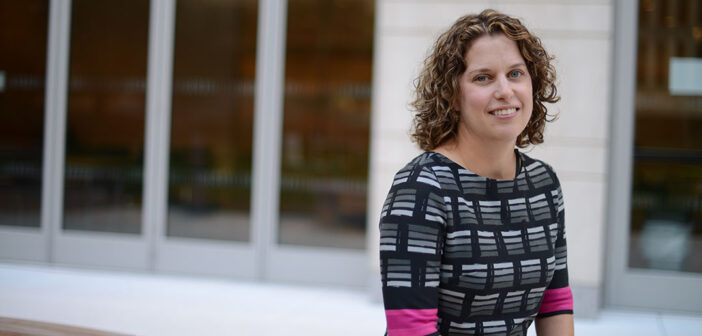You can’t learn the answer if you don’t ask the question. So why do teachers ask all the questions in the class?
Molly Ness, Ph.D., associate professor of education in the Graduate School of Education’s Division of Curriculum and Teaching, wants teachers to embrace the innate curiosity of children that might lead them to ask queries such as “When you lose weight, where does it go?”
“Having kids generate questions themselves is one of the most effective strategies not just in reading comprehension, but in general content knowledge and retention. Recent research indicates that brain’s chemistry changes when we become curious, helping us better learn and retain information.” she said.
“But if you look at the research, questioning is really not happening in classrooms.”
There’s a certain irony in that the average four-year-old girl will ask 390 questions a day, but when they enter formal schooling, the situation is flipped. Teachers will ask on average 400 questions a day, and often view off-topic questions as distractions that they don’t have time to address. Or worse, they view it as a challenge to the power dynamic in the classroom.
“Teachers are not all that proficient at leading classroom discussions, and there’s a fair amount of research that says that letting kids initiate discussions is somewhat of a shift for them,” Ness said.
Enter the Parking Lot. While visiting the classroom of a former student of hers who is now a third-grade teacher, Ness found that he’d been letting students write their off-topics or difficult questions on a piece of paper, which was then “parked” on a poster on the classroom door. Although he’d planned to answer them in a timely manner, he conceded that questions would sometimes go for weeks without answers.
Ness set out to help him use the questions, and detailed the experience in “Moving Student’s Questions Out of The Parking Lot,” an article she published in The Reading Teacher last year. That in turn lead to “The Question is the Answer: Supporting Student-Generated Queries in Elementary Classroom,” which Ness wrote over the summer on a Fordham Fellowship, and which will be published in 2015 by Rowman & Littlefield.
“The book will showcase how naturally curious and inquisitive young children are,,the academic and motivational benefits of question generation, and practical solutions and teaching strategies to help kids to come to the answers themselves. The goal is to help teachers and parents implement engaging ways to not promote questioning but to also help kids discover the answers to their own questions,” she said.
Inquiry-based instruction is not new, but it has taken on added importance in classrooms today thanks to the Common Core State Standards, which places a greater emphasis on both question generation and addressing these questions with informational or expository text. Ness’ research focuses broadly on reading comprehension, as well as the instructional beliefs and decisions of K-5 teachers.
“Kids 10 years ago were spending the majority of their time entrenched in narrative text, and now they’re are spending about 50 percent of their time in narrative and 50 percent in expository text,” she said. “That means a whole different way of approaching texts.”
Informational text conveys information about the natural or social world. Children struggle with it the most because it often features an overwhelming amount of information with no real text structure, technical vocabulary, and timeless verb tenses.. But it’s crucial to master, said Ness, because as we transition into adulthood we read more informational text and less narrative text.
“If I were to ask you – as a proficient adult reader – to make a list of 15 things you read today, the majority of them would probably be informational: directions on a subway map, an article that you read in USA Today, an e-mail, or a recipe—those sorts of things,” Ness explained.
She has found the Parking Lot concept so useful that she uses it with her own four-year-old daughter when she wants to know (at 7:30 a.m.) why the sun seems to follow her through the day. Ness will jot the question down on sticky notes. When it’s time to go to the library, she retrieves the notes, and they decide which questions to address using informational text.
Throughout the process of writing the book, Ness has been amazed at the number of “thick” questions that friends and colleagues have shared. Thick questions are the big, juicy ones that lead to debate, discourse, reflection, and conversation.
“A child was asking about the water cycle, and they had learned that the percentage of salt in our bodies is the same percentage of salt in the oceans,” she said. “The child said, ‘If the salt in my tears is the same amount of salt in the ocean, why when I go swimming, does it hurt when I open my eyes underwater, but it doesn’t hurt when I cry?” she said.
“The teacher and I were like, ‘I have no idea, but that’s a brilliant question.”



